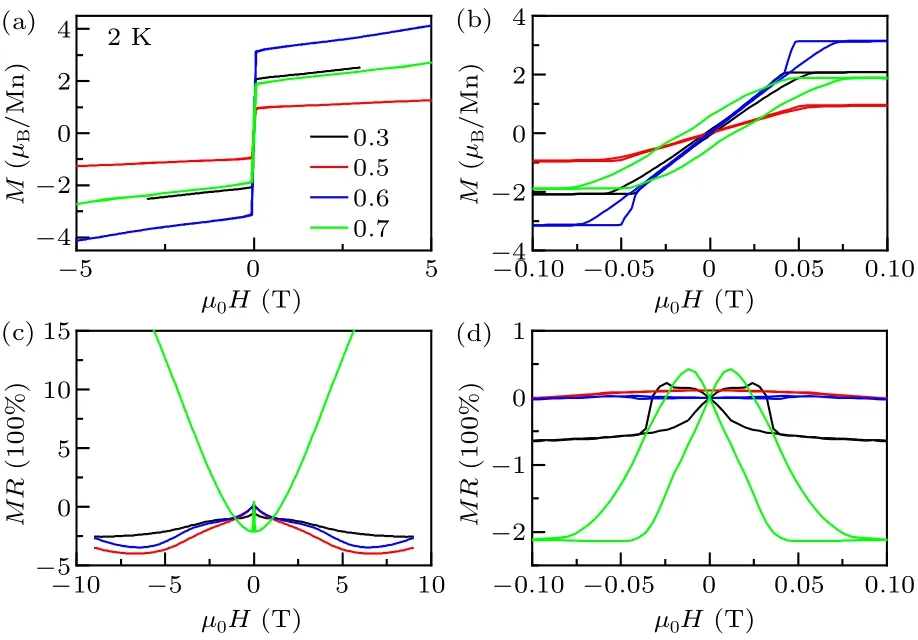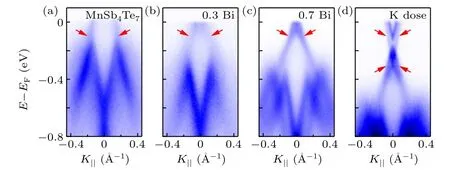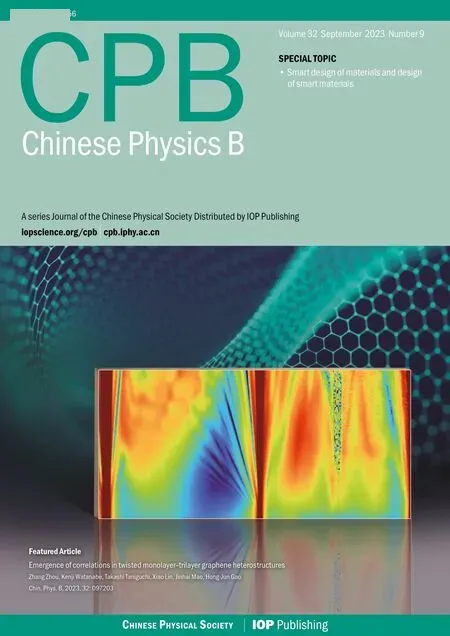Doping tuned anomalous Hall effect in the van der Waals magnetic topological phases Mn(Sb1-xBix)4Te7
Xin Zhang(张鑫), Zhicheng Jiang(江志诚), Jian Yuan(袁健), Xiaofei Hou(侯骁飞), Xia Wang(王霞),Na Yu(余娜), Zhiqiang Zou(邹志强), Zhengtai Liu(刘正太),6,†, Wei Xia(夏威),5,‡,Zhenhai Yu(于振海), Dawei Shen(沈大伟), and Yanfeng Guo(郭艳峰),5
1School of Physical Science and Technology,ShanghaiTech University,Shanghai 201210,China
2State Key Laboratory of Functional Materials for Informatics,Shanghai Institute of Microsystem and Information Technology(SIMIT),Chinese Academy of Sciences,Shanghai 200050,China
3Analytical Instrumentation Center,School of Physical Science and Technology,ShanghaiTech University,Shanghai 201210,China
4National Synchrotron Radiation Laboratory,University of Science and Technology of China,Hefei 230029,China
5ShanghaiTech Laboratory for Topological Physics,ShanghaiTech University,Shanghai 201210,China
6Center of Materials Science and Optoelectronics Engineering,University of Chinese Academy of Sciences,Beijing 100049,China
Keywords: anomalous Hall effect,doping,topological materials
1.Introduction
The quantum anomalous Hall effect (QAHE) has attracted considerable interest in recent years owing to its virtue of dissipationless conduction and hence the potential applications in topological computation and other low-consumption devices.The QAHE was observed for the first time in Crdoped (Bi, Sb)2Te3thin film, but the realization temperature is only at sub-Kelvin temperature range due to the small surface gap and disorders cause by the extrinsic doping.[1]To avoid these problems, intrinsic magnetic topological materials are preferable.The intrinsic magnetic topological phases MnBi2Te4/(Bi2Te3)n(n= 1, 2, 3) have therefore attracted vast attention in recent several years, which exhibit an array of exotic unconventional topological quantum states such as the QAH insulators, axion insulators and magnetic Weyl semimetals(WSMs).[2–6]The prototype member MnBi2Te4is an A-type antiferromagnetic(AFM)topological insulator(TI)by naturally stacking the septuple-layer (Te–Bi–Te–Mn–Te–Bi–Te) via van der Waals (vdW) bonding along the crystallographicc-axis,[7]which exhibits a QAH effect at~1.4 K and could be raised up to 6.5 K through turning the Fermi levelEFexactly into the surface exchange gap via gating.[8]However, the realization of QAHE in MnBi2Te4requires external magnetic field to align the spins along the same direction,i.e.,the system enters into the ferromagnetic(FM)state.The insertion of nonmagnetic quintuple layers(Te–Bi–Te–Bi–Te) into the adjacent MnTe magnetic double layer has been demonstrated as an effective route favoring the FM interaction, which led to the discovery of other members (n= 1,2, 3) in the MnBi2Te4/(Bi2Te3)nfamily.At present, only MnBi8Te13(n=3)achieves an FM ground state and shows a clean hybridization gap in the surface state.[9–11]However,the QAHE can only be observed in then=0 and 1 members up to now.To widely demonstrate the exotic topological properties in MnBi2Te4/(Bi2Te3)nand raise the working temperature favoring the technical applications,it is of urgent necessity to explore other analogue materials.
The MnSb2Te4/(Sb2Te3)nsystem is an analogue to the MnBi2Te4/(Bi2Te3)nfamily.At present, only then= 0, 1,2 members are available and then= 2 member displays fragile FM ground state.[12–14]However, by tuning the Mn–Sb antisite defects, the MnSb2Te4can also achieve the FM state.[15–17]For then=1 member, it shows an intriguing robust axion insulator state regardless of whether the specific magnetic configuration stays at the A-type AFM state or is an external magnetic field driven spin-polarized states, thus providing an excellent platform for studying the axion insulator physics.[13]In the experiment,MnSb4Te7is intrinsically hole doped and theEFis about 180 meV away from the Dirac point(DP),which therefore behaves as a Weyl semimetal with multiple Weyl nodes in the highest valence bands and lowest conduction bands.Tuning theEFto be close to DP is necessary to explore QAHE and other exotic topological properties.The previous work showed that substitution Sb for Bi in MnBi4Te7can achieve the FM state and modify the carrier densities,[18–20]which is instructive to replace the Sb by using Bi in MnSb4Te7.
We report herein the single crystal growth of Mn(Sb1-xBix)4Te7(x= 0.3–0.7) and systematic characterizations of the structure,magnetizations,magnetotransport and electronic band structure properties.It is found that the Sb substitution is not only capable of realizing the FM state, but also significantly tunes the location of theEFof MnSb4Te7.
2.Experiment
The Mn(Sb1-xBix)4Te7(x=0.3,0.5,0.6 and 0.7)single crystals were grown by using the self-flux method.Starting materials of Mn (99.95%), Bi (99.999%), Sb (99.999%) and Te (99.999%) blocks were mixed with a specific molar ratio in an alumina crucible, which was then sealed into a quartz tube in vacuum.The assembly was heated in a furnace up to 700°C within 10 h and kept at that temperature for 10 h,then cooled down to 625°C in 10 h and slowly cooled down to target temperatures which are shown in Table S1.The assemblies were taken from the furnace and immediately put into a centrifuge to separate the flux and then black crystals with shining surfaces were left in the crucible.
The crystallographic phase and quality of the crystals were examined on a Bruker D2 advance powder x-ray diffractometer (PXRD) with CuKα1(λ= 1.54184 ˚A) at 298 K.Both (001) surfaces of the crystals were exfoliated to obtain a flat and shiny surface by using the scotch tape method before the following characterizations.Chemical compositions were measured by using the energy dispersive spectroscopy(EDS)on a Phenom-World BV.Three regions were randomly selected on each crystal for the measurements.The measured Sb contents are summarized in Table S2.It is apparent that the Mn contents are less than the nominal ones possibly due to the intrinsic Mn–Sb antisite defects.
The magnetization measurements were performed in a commercial magnetic property measurement system.The magnetic susceptibilityχ(T)was measured between 2 K and 300 K with the zero-field-cooling (ZFC) and field-cooling(FC) modes.During measurements, a magnetic fieldµ0H=100 Oe was applied with bothH‖candH‖ab.The isothermal magnetization(M(H))was measured within the magnetic field and temperature ranges of±5 T and 2 K–15 K, respectively.The magnetotransport measurements on the freshly cleavedabplane of the crystals by using a standard six-probe method were conducted in a physical properties measurement system.During measurements of the longitude magnetoresistivity (ρxx) and Hall resistivity (ρxy), the current was applied within theabplane (I‖ab) and the magnetic field was parallel to thec-axis(H‖c).Magnetic field dependences ofρxxandρxywere symmetrized by usingρxx=[ρxx(+H)+ρxx(-H)]/2 andρxy=[ρxy(+H)-ρxy(-H)]/2,respectively.
3.Results and discussion
Figure 1(a) shows the room temperature PXRD of Mn(Sb1-xBix)4Te7.The clean diffraction peaks arising from the (001) surface of the crystals demonstrate the high quality of the samples used herein.The positions of the peaks slightly shift with differentxvalues indicated by the dotted line in Fig.S1, implying the change of lattice constants upon Bi substitution.[19]The temperature dependentρxxforx=0.3,0.5, 0.6, 0.7 are presented in Fig.1(b), which display clear kinks caused by magnetic scattering at about 13 K signifying the AFM transition.The enlarged views ofχ(T) andρxx(T)between 2 K and 30 K are presented in Figs.1(c)–1(f),showing a coincident N`eel temperatureTNdetermined by the cusps.Forx=0.3, an AFM transition occurs at 12.8 K manifested by the cusps inχ(T) for bothH‖candH‖ab.As shown in Figs.S2(a) and 2(b), the spin-flop transition ofM(H) curve and the platform ofρxx(H)at 12 K demonstrate the existence of AFM order.With further cooling,χ(T) of ZFC and FC data forH‖cshow a rise at 11.8 K and a separation at 6 K,suggesting the establishment of FM order and the existence of hysteresis at low temperatures.The hysteresis ofM(H) and butterfly-shaped loop ofρxx(H) data as shown in Figs.S2(a)and 2(b)support further evidence for the FM state.The magnetic transition could be explained by involving the competition between the AFM and FM orders.[21]
As seen in Fig.1(d), forx=0.5, an AFM transition occurs at 13.1 K manifested by the cusps inχ(T) forH‖c.However,χ(T) of ZFC and FC data shows a separation at about 11 K upon further cooling, which is larger than that ofx=0.3.No plateaus are observed inM(H) andρxx(H),as shown in Figs.S3(a) and 3(b), manifesting the absence of AFM order.
While forx=0.6,χ(T) of ZFC and FC data forH‖cpresented in Fig.1(e) shows a rise at 10 K and a separation at 7 K.A similar situation occurs again forx=0.7.As seen in Fig.1(f),χ(T)exhibits a clear rise and separation between ZFC and FC data at~5 K,suggesting the establishment of FM order as also indicated by theM(H) presented in Fig.S5(a).Seen in Figs.S5(a)–S5(c),theM(H)forx=0.7 displays steplike features above 6 K though clear hysteresis loops are visible, corresponding to the AFM or ferrimagnetic state.With further cooling, the hysteresis area becomes larger and the step-like feature gradually vanishes, suggesting that the FM component gradually becomes dominated below 6 K,consistent with the result as seen inχ(T).It is also manifested by theρxx(H) shown in Fig.S5(b) by the clear butterfly-shaped curve and a clear hysteresis loop without step-like feature by theM(H) shown in Fig.S5(b) at 2 K, which is commonly observed in other FM materials.[22]It should be noticed thatρxx(T) forx=0.7 display continuous decrease upon cooling down to 17 K and then an upturn with further cooling with a slope change atTN.This behavior may be attributed to thatxof 0.7 which is approaching CNP and the carrier density is very small.Such phenomenon was also observed in Mn(Bi0.74Sb0.26)2Te4.[23]

Fig.1.(a) The PXRD for Mn(Sb1-xBix)4Te7.(b) The temperature dependence of ρxx(T) at 2 K–300 K with different x values.(c)–(f) The temperature dependent χ(T) and ρxx measured at 2 K–300 K with x=0.3, 0.5, 0.6 and 0.7, respectively.The χ(T) was measured underµ0H =10 mT between 2 K and 300 K.The blue and red dashed lines represent zero-field cooling(ZFC)and field-cooling(FC)data for H‖ab,respectively.The black and red solid lines represent ZFC and FC data for H‖c,respectively.
To obtain a clear comparison,theM(H)forx=0.3,0.4,0.5,and 0.7 at 2 K are presented together in Fig.2(a)and also in Fig.2(b)with enlarged views.It is apparent that all samples show step-like features in the low field range ofµ0H <0.1 T,but thex=0.3 and 0.7 show much clearer hysteresis loops than the other two compositions, likely suggesting larger FM components in these two samples.This could also be demonstrated by the clear butterfly-shapedρxx(H)curves forx=0.3 and 0.7 at 2 K, seen in Fig.2(d).As seen in Fig.2(b) by the isothermal magnetizations, underµ0H <0.1 T, the magnetic field driven spin-polarized states can reach their saturation.It is clear that the saturation moment forx=0.5 is much smaller(~1µB/Mn)than those of other components, which might be related to the more Mn vacancies and Mn–Sb antisite defects in the sample.As shown in Fig.2(c), the negativeMR(MR=[ρxx(H)-ρxx(0)]/ρxx(0)×100%) at the low magnetic field results in the suppression of spin-disorder scattering and the upturn at the high magnetic field forx=0.5 andx= 0.6 is caused by the contribution of nonmagnetic(Sb1-xBix)2Te3.[9,21]In addition,the W shapedMRforx=0.7 with positive values at the high magnetic field is due to the large carrier mobility.We have calculated the carrier mobility by usingµH=RH/ρxx(0),whereRHis the slope ofρxy(H)andρxx(0)is the longitudinal resistivity at zero field.As shown in Fig.3(c),the results show that the carrier mobility forx=0.7 is about 1527 cm2·V-1·s-1, which is much larger than those of other samples.Hence,a large positiveMRis observed,resembling the case in Mn(Bi1-xSbx)2Te4.[24]

Fig.2.(a)and(b)Isothermal magnetizations and(c)and(d)magnetoresistance versus magnetic field at 2 K and different magnetic field ranges for x=0.3,0.4,0.5 and 0.7.

Fig.3.Evolution of the Hall data for Mn(Sb1-xBix)4Te7 with x=0.3,0.4, 0.5, and 0.7 at 2 K.The Hall resistivities are shown under the magnetic field from(a)-9 T to 9 T and(b)-0.1 T to 0.1 T.(c)The carrier mobility and carrier density were extracted from the linear region under the high magnetic field(µ0H >5 T).(d)The Hall resistivity.The left two diagrams represent the positive σAH and the right two diagrams show the negative σAH.
The Hall resistivityρxy(H) for all doped samples is depicted in Fig.3(a), showing that the slopes ofρxy(H) forx= 0.3, 0.5 and 0.6 are negative while that forx= 0.7 is positive, suggesting the change of carrier type from p- to ntype and a charge neutrality point (CNP) betweenx= 0.6 and 0.7.The result is similar to that of Sb-doped MnBi2Te4samples.[18,19]The carrier densities are calculated by usingn= 1/RH·e, where the Hall coefficientRHis the slope ofρxy(H) andeis the electron charge.Figure 3(c) shows the carrier densities extracted fromρxy(H) at 2 K within the linear region atµ0H >5 T.The carrier density forx=0.7 is much smaller than that of other samples, indicating that its chemical potential is close to the edge of the conduction or valence band,which is also proved by our ARPES data presented later.Furthermore,we measure another sample(sample 2)ofx=0.7 to guarantee the reliability of the result and the same behavior as shown in Fig.S6 is observed, suggesting the intrinsic property of the composition.
Theρxy(H)forx=0.3 and 0.5 at 2 K both show positive slopes in the high magnetic field region,while displaying significant deviations from the linear field evolution, likely suggesting a multiple band effect.The Hall resistivityρxy(H)forx=0.3 shows a negative slope while that ofx=0.5 shows a positive slope in the low magnetic field region.The results unveil a reversal of the anomalous Hall conductanceσAH.According toσAH=e2·(-C)/h,whereCis the Chern number.TheCvalue of-1 leads to a positive AHC andC=+1 results in a negative AHC,[25]as shown in Fig.3(d).Considering that the Chern numbers represent different topological states,the reverse sign ofσAHstrongly suggests a topological phase transition betweenx=0.3 andx=0.5.

Fig.4.The ARPES intensity plot taken at 8 K along the ¯Γ–¯K direction for Mn(Sb1-xBix)4Te7(x=0,0.3,0.7)and K-doped Mn(Sb0.3Bi0.7)4Te7.The red arrows present the topological surface states.
We use the synchrotron-based angle-resolved photoemission spectroscopy (ARPES) to probe the low-energy band structures forx=0, 0.3 and 0.7, with the results shown in Figs.4(a)–4(c).These ARPES spectra demonstrate the prominent p-type carrier for all samples.Forx=0, as studied in our previous work, theEFis located at~180 meV below the DP.[13]With the substitution of Bi for Sb, theEFis apparently gradually shifted up, as seen in Figs.4(b) and 4(c).Whenx=0.7,theEFis close to the edge of conduction band,while the DP is invisible yet.With potassium surface doping, the DP is eventually visible by the gapless surface state.The results demonstrate that thex=0.7 is actually close to the CNP in this material.However, it should be noted that,the ARPES data show that thex=0.7 sample is still slightly p-type, which is different from our Hall effect measurement which shows n-type carriers.The discrepancy might be due to that the Hall effect measurements probe the bulk while the ARPES is a surface-sensitive technique and only probes fewlayer of the cleaved crystal.Small differences in compositions can bring large influence on theEFat the surface,and hence inconsistence of the properties with the bulk.Such phenomenon was also observed in a previous measurement on the analogue system.[24]
4.Conclusion
We grow a series of Bi-doped MnSb4Te7crystals and measure the magnetizations, magnetotransport and electronic band structure,which show that the Bi substitution favors the FM exchange and shifts up the Fermi level towards the Dirac point.With the Bi substitution, the Hall resistivityρxy(H)changes from positive to negative betweenx=0.6 and 0.7,andσAHchanges from negative to positive betweenx=0.3 and 0.5.These behaviors are tightly related to the electronic band structure and provide the opportunity to study the carrier doping induced topological phase transition in MnSb4Te7.The doping strategy is also instructive for the exploration of exotic topological properties in other magnetic topological phases.
Acknowledgments
Project supported by the Shanghai Science and Technology Innovation Action Plan (Grant No.21JC1402000),the National Natural Science Foundation of China (Grant No.12004405),the State Key Laboratory of Functional Materials for Informatics(Grant No.SKL2022), the Double First-Class Initiative Fund of ShanghaiTech University,the Analytical Instrumentation Center(Grant No.SPST-AIC10112914),SPST, and ShanghaiTech University.W.Xia acknowledges the research fund from the State Key Laboratory of Surface Physics and Department of Physics of Fudan University(Grant No.KF202213).
- Chinese Physics B的其它文章
- Robustness of community networks against cascading failures with heterogeneous redistribution strategies
- Identifying multiple influential spreaders in complex networks based on spectral graph theory
- Self-similarity of complex networks under centrality-based node removal strategy
- Percolation transitions in edge-coupled interdependent networks with directed dependency links
- Important edge identification in complex networks based on local and global features
- Free running period affected by network structures of suprachiasmatic nucleus neurons exposed to constant light

